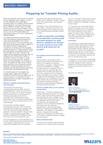Preparing for Transfer Pricing Audits
Since the introduction of the Income Tax (Transfer Pricing) Regulations 2018 in Nigeria, it is fair to say that companies have started paying increasing attention to complying with the transfer pricing regulations. Ever since, there has only been a handful of Transfer Pricing (TP) audits carried out by the tax authority in Nigeria. This is because the 2018 TP regulations is relatively new and, as such, the FIRS is still collating and analyzing the plethora of TP returns submitted by affected taxpayers.
The Federal Inland Revenue Service (FIRS), which had temporarily postponed ongoing TP audits during the pandemic, lost no time in resuming the audit as soon as the lockdown was lifted during the last quarter of 2020. In addition to the ongoing TP audit on related parties’ transactions, the tendency that more taxpayers would be chosen for a TP desk review/TP audit is quite high going by the increasing request for TP documentation by the FIRS. Common audit triggers include companies having high volume of transactions with related entities resident in jurisdictions having no income tax or whose income tax rate is less than 30%; consistent losses; fluctuating profitability; or extremely low profits. Companies with high volume of related party transactions such as intra-group services, dividends, or intellectual property, as well as companies that have gone through restructurings, are more likely to be selected for TP audit.
It is therefore important that taxpayers take strategic steps to assess their controlled transactions and ensure they are ready for any TP audit that may occur.
Maintain a detailed contemporaneous documentation
The importance of maintaining a contemporaneous documentation cannot be overemphasized as it serves as the first line of defense in the event of a TP audit. The transfer pricing documentation is the starting point for reducing potential disputes with the tax authorities. The TP documentation should demonstrate that the intra-group transactions are carried out in a manner consistent with the arm’s length principle.
Documentation should be prepared contemporaneously (that is, when executing a transaction with a related entity, taxpayers must ensure that transfer pricing documentation is prepared). If there are significant changes during the year, the transfer pricing documentation should be revised before the deadline for filing income tax return for that assessment year.
The mere existence of a TP documentation is not enough to discharge the burden of proof that rests on the taxpayer. These documents must be supported by verifiable facts such as contract agreements with related entities and third parties, account statements, receipts, schedule of loan from related parties, loan repayment schedule. etc.
Nonetheless, since transfer pricing is not an exact science, it cannot be assured that the FIRS would agree with the taxpayers' position in the transfer pricing documentation during a TP audit.
Be strategic about the information you provide
The information to be provided must be relevant and accurate for the purpose of the audit and must address the necessary requirements or questions. Taxpayers should try as much as possible not to release information that are not requested by the tax authority which may eventually raise new questions that are outside the scope of the audit. Also, taxpayers should not hold back relevant information just so it does not imprint an impression that the taxpayer has not been complying with the TP regulations or the arm’s length principle. Above all, taxpayer should take charge of releasing information or documents including information disclosed in its audited financial statements.
Perform a health check of your transfer pricing status
Another factor to consider in preparing for a transfer pricing audit is to perform a TP health check in order to identify areas of potential TP risks and determine ways to mitigate the risk. The health check may be performed in-house or to engage the service of an external consultant with vast knowledge and experience. This can be done by establishing arm's length price, documenting it, implementing it in the accounting system, preparing or amending intercompany legal agreements, and settlement of intercompany accounts. Taxpayers with controlled transactions are expected to proactively plan for TP audits by implementing plans to mitigate the risks that exist.
Seek professional help
It is pertinent that taxpayers seek professional assistance from a transfer pricing consultant since a TP consultant understands how best to respond to information requests and how to portray a company in the best light to produce the best results.
A TP consultant, due to the broad range of experience, will gain control of the transfer pricing audit and prevent the tax authorities from using the opportunity of an audit to expand the scope of their investigation into other areas. It is essential to manage the tax authorities' expectations and to keep the investigation under control.
Conclusion
The complexity of transfer pricing audits has recently increased, emphasizing the need for taxpayers to place high importance on the documentation process. Although, there are many factors to consider when preparing for a transfer pricing audit, the four main factors mentioned above remains the most important in achieving a more favorable outcome in the event of a transfer pricing audit.
It is important to note that audits are generally unavoidable as tax authorities routinely profile and select taxpayers for audit. However, taxpayers can manage the audit process to ensure that adverse audit exposures are avoided.

